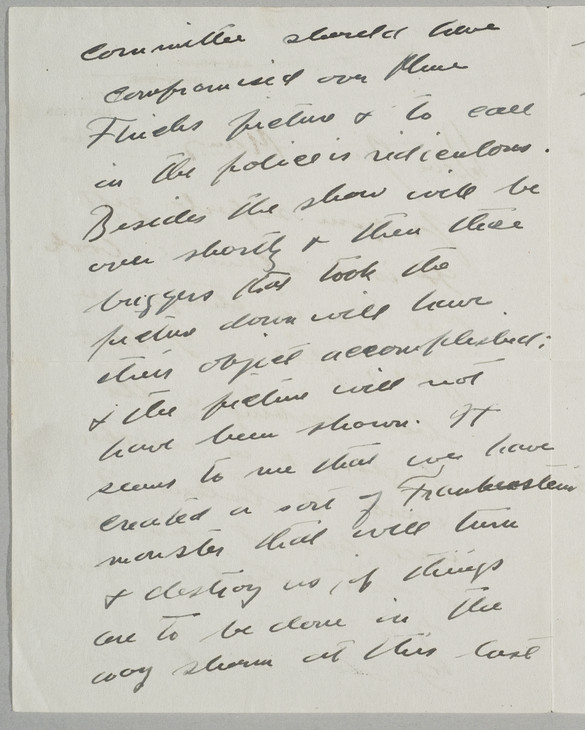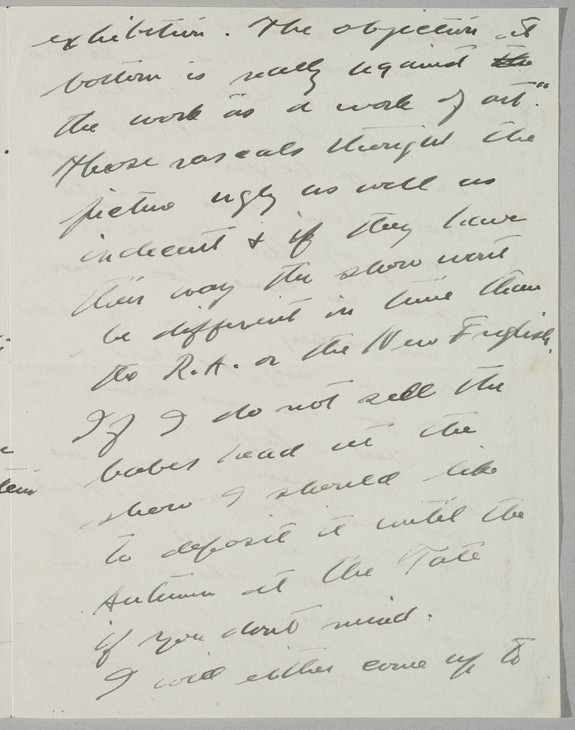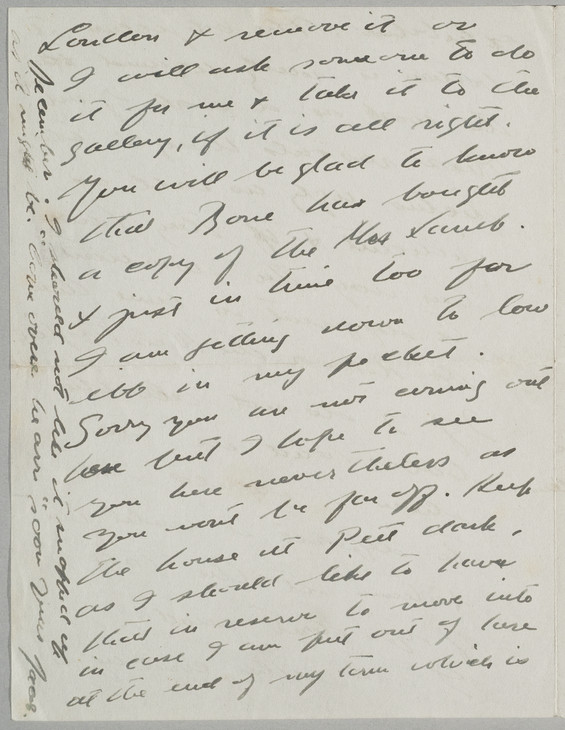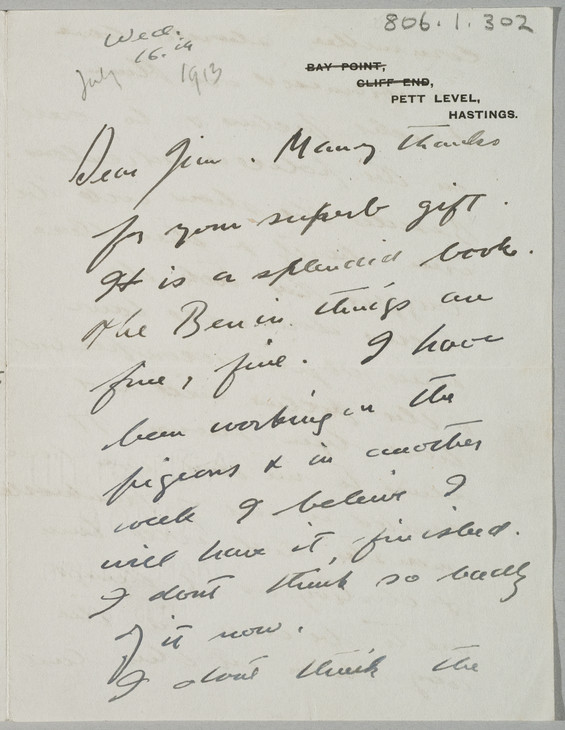Jacob Epstein Letter to James Bolivar Manson July 1913
The sculptor Jacob Epstein and the painter James Bolivar Manson met in 1903 when they shared a studio in Paris while studying. Despite their artistic differences, the two became good friends and obviously encouraged and helped one another.
In this letter Epstein refers to the recent controversy surrounding a painting of a male nude with blue pubic hair, by Renée Finch, which was taken down from the Allied Artists’ Association exhibition. He is angry that the committee agreed to take the picture down and thinks that ‘the show won’t be different in time than the R.[oyal A.[cademy] or the New English [Art Club]’. This is possibly one reason that led to the formation of the London Group, with Finch as member (see TGA 806/10/6).
Manson had taken a job at the Tate Gallery in 1912. Here Epstein asks if he can store his ‘babes head’ at the gallery if it does not sell at the exhibition. In the catalogue the work is entitled Head of a Babe, priced £31 10s, and dated 1907. According to Malcolm Easton, this work was not sold in the exhibition and eventually became part of Manson’s collection. In 1913 Epstein had moved to a remote coastal village called Pett Level in Sussex so possibly did not have storage space in London.
Epstein also remarks that the artist Muirhead Bone, a staunch ally of the sculptor, ‘has bought a copy of the Mrs Lamb’. Bone purchased a portrait sculpture of Henry Lamb’s then wife, Nina ‘Euphemia’ Forrest, entitled Second Portrait of Euphemia Lamb (half-length) 1911 (private collection, third edition reproduced in Evelyn Silber, The Sculpture of Epstein with a Complete Catalogue, Oxford 1986, no.33). Euphemia modelled for numerous artists at the time, including Lamb, James Dickson Innes, Augustus John and Ambrose McEvoy (N04447), and had several poems dedicated to her by Aleister Crowley. As well as the Second Portrait, Epstein sculpted Euphemia in another four works, including one from 1908 in the Tate collection (N03187).
Manson spent the August of 1913 on a painting trip in Sussex with Lucien Pissarro, James Brown and their families. They stayed at Western House on the outskirts of Rye, close to Pett Level (see TGA 792/21). Epstein remarks, ‘Sorry you are not coming out here but I hope to see you here nevertheless as you won’t be far off’. Manson and Pissarro did visit Epstein at Pett Level during their trip. See also TGA 792/17, TGA 806/1/300, TGA 806/1/301, TGA 806/1/303 and TGA 806/1/304.
Wendy Baron, Perfect Moderns: A History of the Camden Town Group, Aldershot and Vermont 2000, p.58.
Malcolm Easton, ‘Lucien Pissarro and his Friends at Rye, 1913: A Group of Post-Impressionists on Holiday’, Gazette des Beaux-Arts, November 1968, pp.237–48.
Malcolm Easton, Three on Holiday at Rye 1913. A Group of Post Impressionists: Lucien Pissarro, James Bolivar Manson, James Brown, exhibition catalogue, Parkin Gallery, London 1980.
Evelyn Silber, The Sculpture of Epstein with a Complete Catalogue, Oxford 1986.
Malcolm Easton, ‘Lucien Pissarro and his Friends at Rye, 1913: A Group of Post-Impressionists on Holiday’, Gazette des Beaux-Arts, November 1968, pp.237–48.
Malcolm Easton, Three on Holiday at Rye 1913. A Group of Post Impressionists: Lucien Pissarro, James Bolivar Manson, James Brown, exhibition catalogue, Parkin Gallery, London 1980.
Evelyn Silber, The Sculpture of Epstein with a Complete Catalogue, Oxford 1986.
Transcript
[Handwritten:]
Wed.
16. [...]
July 1913
Wed.
16. [...]
July 1913
[Letterhead:] BAY POINT,
CLIFF END,
PETT LEVEL,
HASTINGS.
PETT LEVEL,
HASTINGS.
Dear Jim. Many thanks for your superb gift. It is a splendid book. The [?Beu in] things are fine, fine. I have been working on the pigeons & in another week I believe I will have it finished. I don’t think so badly of it now.
I don’t think the [end of p.1] committee should have compromised over Mrs Finch’s picture & to call in the police is ridiculous. Besides the show will be over shortly & then those buggers that took the picture down will have their object accomplished; & the picture will not have been shown. It seems to me that we have created a sort of Frankenstein monster that will turn & destroy us, if things are to be done in the way shown at this last [end of p.2] exhibition. The objection at bottom is really against the the work as a work of art. Those rascals thought the picture ugly as well as indecent & if they have their way the show won’t be different in time than the R.A. or the New English.
If I do not sell the babes head at the show I should like to deposit it until the Autumn at the Tate if you don’t mind. I will either come up to [end of p.3] London & secure it or I will ask someone to do it for me & take it to the gallery, if it is all right. You will be glad to know that Bone has bought a copy of the Mrs Lamb. & just in time too for I am feeling down to low ebb in my pocket.
Sorry you are not coming out here but I hope to see you here nevertheless as you won’t be far off. Keep the house at Pett [?dark] as I should like to [?leave that] in reserve to move into in case I am put out of [?here] at the end of my term which is [vertical down side of sheet] December. I should not like it [?supposed of] as it might be. Come over [?here] soon[.] Yours Jacob.
If I do not sell the babes head at the show I should like to deposit it until the Autumn at the Tate if you don’t mind. I will either come up to [end of p.3] London & secure it or I will ask someone to do it for me & take it to the gallery, if it is all right. You will be glad to know that Bone has bought a copy of the Mrs Lamb. & just in time too for I am feeling down to low ebb in my pocket.
Sorry you are not coming out here but I hope to see you here nevertheless as you won’t be far off. Keep the house at Pett [?dark] as I should like to [?leave that] in reserve to move into in case I am put out of [?here] at the end of my term which is [vertical down side of sheet] December. I should not like it [?supposed of] as it might be. Come over [?here] soon[.] Yours Jacob.
How to cite
Jacob Epstein, Letter to James Bolivar Manson, July 1913, in Helena Bonett, Ysanne Holt, Jennifer Mundy (eds.), The Camden Town Group in Context, Tate Research Publication, May 2012, https://www




